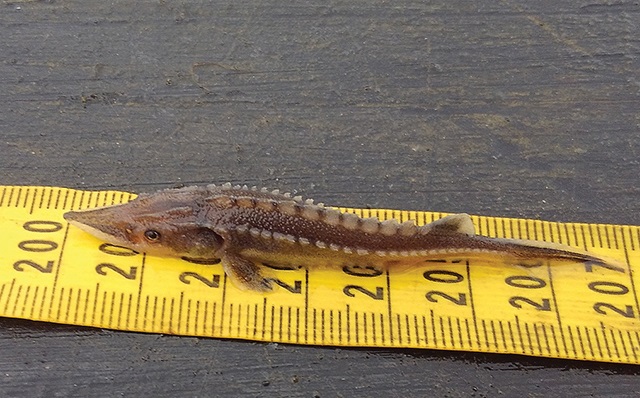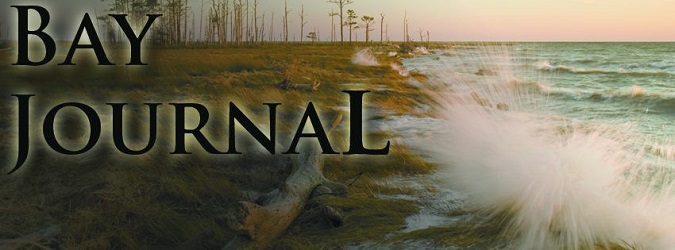
A bumper crop of juvenile Atlantic sturgeon in the James River this fall is raising some environmentalists’ hopes that the endangered fish may be staging a steady comeback in Virginia’s largest river.
“We’re starting to see real momentum to see a species come back, but also a river come back,” said Jamie Brunkow, riverkeeper for the James River Association.
This fall, as of Nov. 12, 153 juvenile sturgeon had been discovered in the James during routine trawling surveys — a staggering increase over last fall’s yield of just two.
Of those, 148 have been caught by Virginia Commonwealth University’s Rice Rivers Center; 40 of them were captured on Nov. 5 alone. All of the center’s catches were made between the Benjamin Harrison Bridge near Hopewell and Sturgeon Point, which sits just west of the Fort Pocahontas historical site in Charles City County. The five juveniles turned up by the James River Association were found in mid-October during an education program at Presquile National Wildlife Refuge.

While the finds have sparked excitement among environmental advocates and researchers — Brunkow called the discoveries “extraordinary” even when the count sat at nine — some are urging caution in claiming a restoration success.
“It is exciting, but it’s still too early to call it for me,” said Matt Balazik, a scientist with Rice Rivers and the U.S. Army Corps of Engineers who specializes in Atlantic sturgeon in the James. “These guys have a long way to go before I’m comfortable with [the rate of juvenile] recruitment.”
Overfished in the Chesapeake region almost to the point of collapse in the 1800s, Atlantic sturgeon (Acipenser oxyrinchus) have been slowly returning to the Bay watershed over the last decade. But in the James River, where researchers have identified and tagged more than 700 adults, juveniles have largely been absent until recent years.
“We seem to have a recruitment problem in the James River of fish surviving when they’re young,” Balazik said.
Researchers aren’t quite sure why juveniles have been so scarce in the James. Some suspect predation by other fish, such as the nonnative blue catfish, may be decimating the ranks of the young. Disappearing habitat may also play a role: For spawning to occur successfully, sturgeon need a hard, rocky river bottom for eggs to adhere to, as well as water with low levels of sediment and high dissolved oxygen content.
Other risks include vessel collisions, the dredging of spawning areas and water intakes at industrial plants.
Although it was clear that juveniles must exist somewhere in the James, none were found by either fishermen or research trawls until November 2016, when three turned up. The next year, two more emerged.
All five of the earlier juveniles, though, were older than this year’s discoveries. The two 2017 finds were 47 and 52 centimeters in length, respectively, while the 2016 juveniles were all less than 43 centimeters in length. Based on their measurements, Balazik estimated them to be about a year old.
In comparison, all of this year’s finds were in the 6–11 centimeter range and classified as “age 0,” meaning they were likely born within the last few weeks around Osborne Landing, where a number of tagged female sturgeon have been detected.
Juveniles ages one to two years “are the ones I really love catching, because those are pretty much safe at that point,” Balazik said.
Mere weeks old at the time of discovery, the 153 juveniles are not assured of reaching maturity, and they are too small to be equipped with tracking devices that could help researchers learn more about how the fish live and grow in the James.
Both Brunkow and Balazik speculated that the high incidence of juveniles this year may be due to the heavy rains that affected the entire James River watershed this summer and fall. Sturgeon move upriver to spawn, and the juveniles move slowly downriver as they grow. Researchers at the Rice Rivers Center no longer conduct trawls above the fall line, though, because of the high incidence of snags their equipment encounters upstream.
“It’s a good chance in a normal year they’re up there, but maybe with the stronger flows, maybe they came downstream a little more quickly,” Balazik said.
While Balazik is tempering his excitement until next year, when researchers can get a sense of how many juveniles survived their treacherous early months, Brunkow sees the finds as a hopeful signal of water quality improvement.
“The sturgeon just happens to be our local mascot here in the James,” he said, and this year’s juveniles offer “some reason to be excited and positive about the future.”
